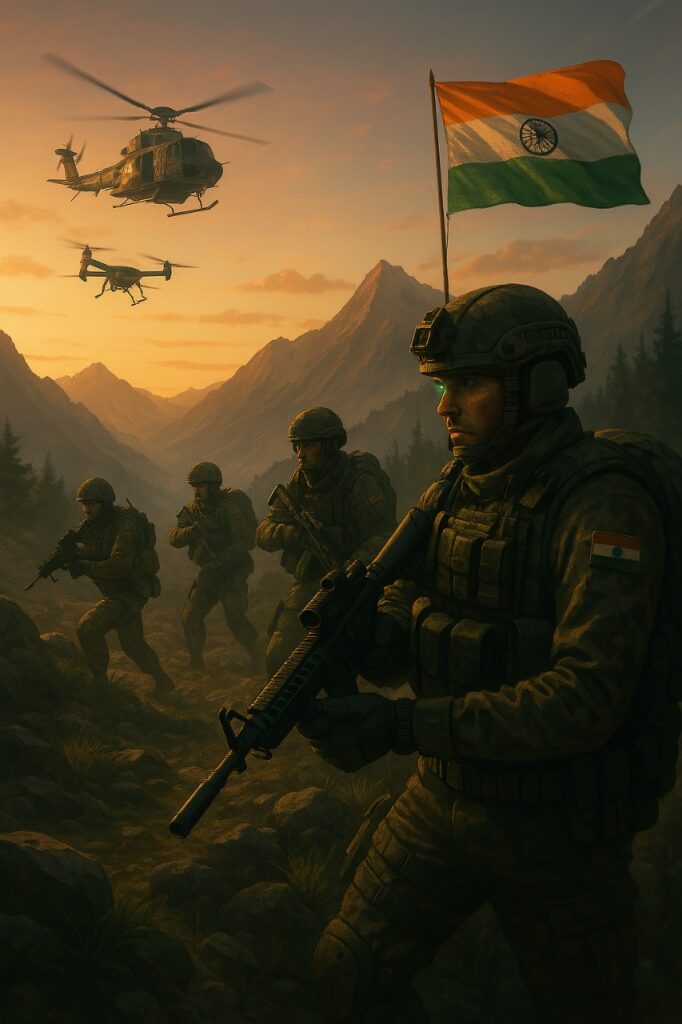India’s defense and strategic landscape has undergone a profound transformation in the past two decades, especially in response to asymmetric warfare and cross-border terrorism. Among the most significant developments is the doctrine and execution of surgical strikes across the Line of Control (LoC). This article explores the evolution of surgical strikes in India, how the doctrine has matured, and what it means for India’s national security, with a clear Indian perspective.
Understanding Surgical Strikes: Concept and Strategy
What Are Surgical Strikes?
Surgical strikes are precision military attacks carried out to neutralize specific threats without causing large-scale collateral damage. In the Indian context, they involve crossing the LoC or international borders to target terrorist camps, launch pads, or hostile infrastructure.
Strategic Purpose
- Deter Cross-Border Terrorism
- Show Military Capability Without Escalation
- Demonstrate Political Resolve
Historical Background: From Covert Ops to Official Doctrine
Pre-2016 Era: Covert and Denied
Before 2016, Indian security forces had reportedly carried out several cross-border raids, but these were unofficial and not publicly acknowledged due to diplomatic concerns.
The Paradigm Shift: 2016 Uri Attack and Response
In September 2016, following the terrorist attack in Uri (Jammu and Kashmir), the Indian Army conducted publicly acknowledged surgical strikes on terrorist launch pads across the LoC. This marked a major shift in India’s defense doctrine.
Key Point: It was the first time the government officially owned and publicized a cross-border military action without triggering a full-scale war.
The 2016 Surgical Strikes: Details and Impact
Operation Details (as available to public domain)
- Date: September 28–29, 2016
- Forces Involved: Para Special Forces
- Objective: Target launch pads used by terrorists in Pakistan-occupied Kashmir (PoK)
- Outcome: Several camps destroyed, significant terrorist casualties
National and Global Reaction
- India: Surge in national pride, political and public support
- Pakistan: Denial of strike; called it routine border firing
- International: Mixed reactions; U.S., Russia, and France tacitly supported India’s right to self-defense
Evolution of Doctrine: From One-Off Response to Strategic Tool

2019 Balakot Airstrikes: New Altitude, New Message
After the Pulwama terror attack in February 2019, India carried out airstrikes deep inside Balakot in Pakistan. This expanded the doctrine beyond ground-based surgical strikes.
- Innovation: Use of Mirage 2000 aircraft
- Target: Jaish-e-Mohammed training camps
- Message: India’s strategic depth and escalation control
Modernization and Capability Enhancement
- Drone Surveillance and Reconnaissance
- Special Forces Training and Upgradation
- Integrated Battle Groups (IBGs)
Strategic Objectives Behind Surgical Strikes
Deterrence and Credibility
Surgical strikes serve as a deterrent to non-state actors and their sponsors by proving India’s will and ability to respond proportionately.
Control Without Escalation
India’s strikes are calibrated to avoid full-scale war while delivering effective retaliation.
Information Warfare
The announcement and framing of surgical strikes also contribute to psychological and narrative dominance.
Challenges and Criticism
Diplomatic Fallout
While these operations enhance domestic perception, they complicate India’s diplomatic engagements, especially with countries like China and in multilateral forums.
Verification and Accountability
Some critics question the lack of visual proof or third-party verification, calling for more transparency.
Escalation Risk
Despite being limited in scope, surgical strikes carry a risk of military escalation if the adversary chooses to retaliate disproportionately.
The Role of Intelligence and Technology
Importance of Real-Time Intelligence
Agencies like RAW, NTRO, and military intelligence units play a critical role in identifying, verifying, and targeting high-value camps.
Integration of Technology
- Satellite Imagery for Reconnaissance
- High-Altitude Surveillance Drones
- Electronic Warfare Capabilities
India’s Legal and Diplomatic Standpoint
International Law
India has consistently framed these operations as acts of self-defense, a principle enshrined in Article 51 of the UN Charter.
Global Diplomacy
Post-strike briefings to international partners, engagement at the UN, and leveraging global forums have helped manage the diplomatic narrative.
The Doctrine Today: Shaping Future Engagements
Formalizing the Strategy
India’s defense policy now includes surgical strikes as a viable option under a ‘proactive and non-provocative’ doctrine.
Military Exercises and Readiness
Regular joint exercises simulate cross-border precision strikes, keeping troops battle-ready.
Civil-Military Integration
Post-strike briefings to national security stakeholders, think tanks, and media help build civil-military cohesion.
Indian Perspective: A New Strategic Culture
India has historically maintained strategic restraint. The surgical strike doctrine indicates a paradigm shift from reactive to proactive engagement, especially when national security and civilian lives are at risk.
Strength in Resolve
- Political Leadership: Decision-making clarity
- Military Professionalism: Execution with precision
- Public Support: National unity
This represents maturity in India’s strategic culture, aligning military responses with diplomatic outreach and global expectations.
Conclusion: The Road Ahead
India’s evolution of surgical strike doctrine shows a clear progression—from covert actions to publicized operations, from border raids to deep airstrikes. It reflects India’s growing confidence in leveraging military strength within a responsible democratic framework.
While challenges remain, surgical strikes have become a vital tool in India’s security doctrine, reinforcing deterrence without reckless escalation.
Key Takeaways:
- India has shifted from strategic restraint to assertive defense.
- Surgical strikes are now part of India’s official security doctrine.
- Intelligence, technology, and diplomacy are deeply integrated.
- The Indian perspective emphasizes responsible power, calibrated response, and national sovereignty.









+ There are no comments
Add yours